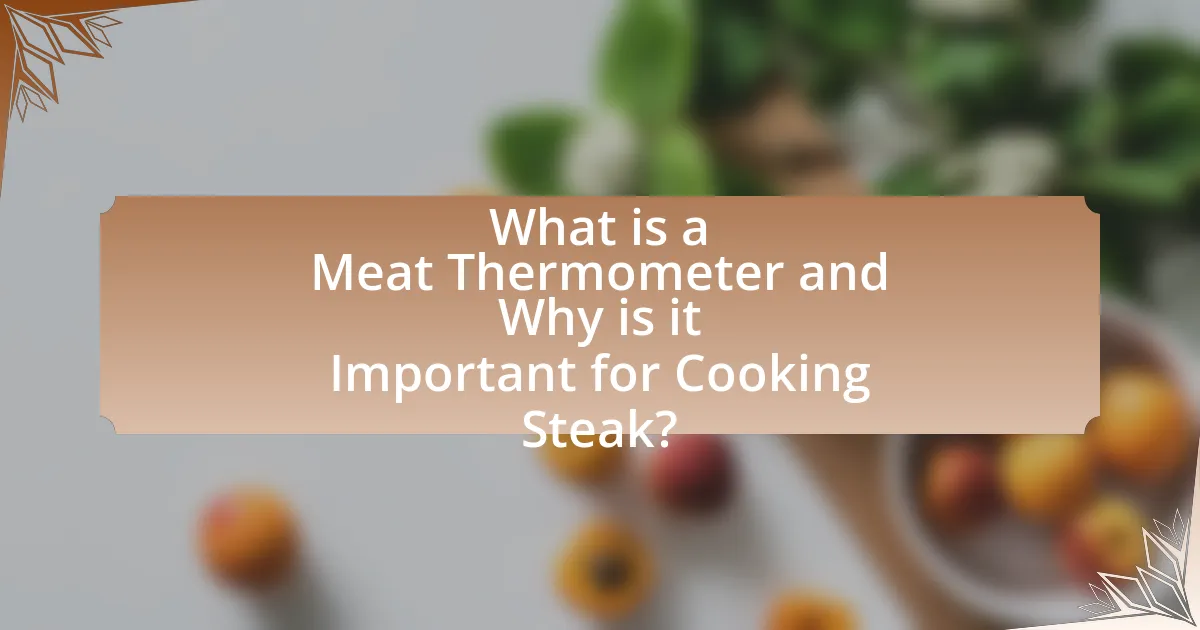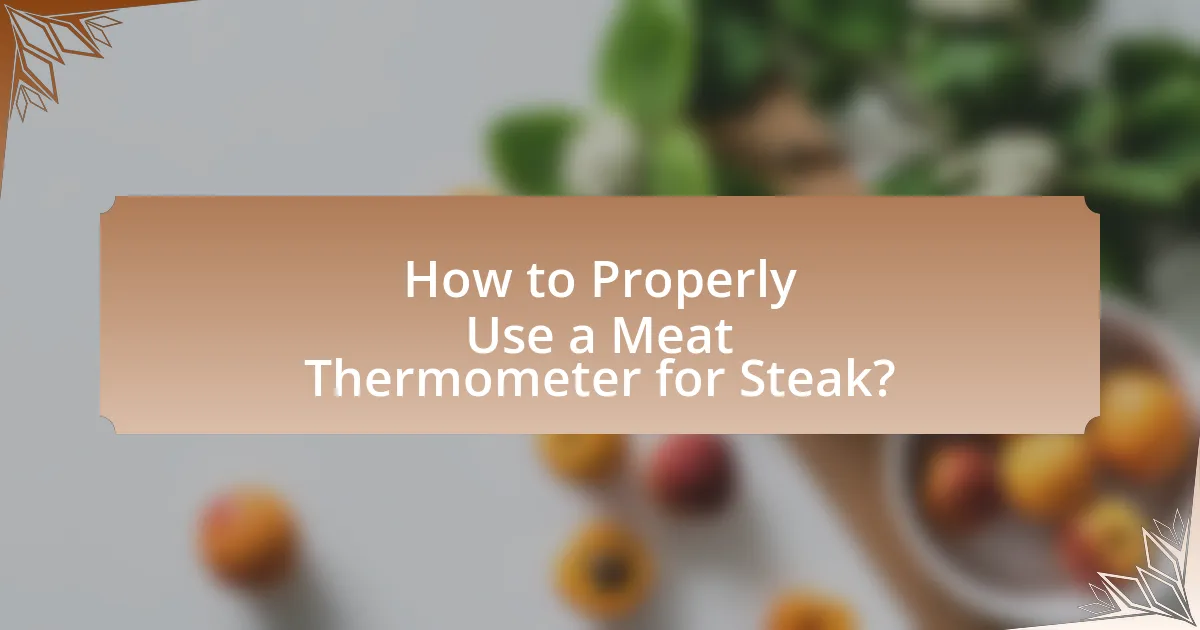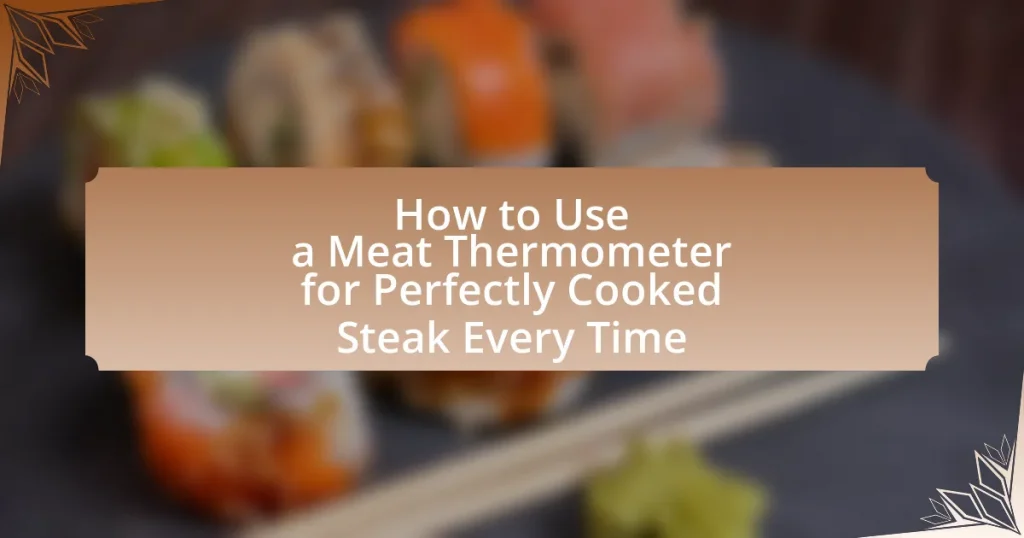A meat thermometer is an essential kitchen tool for accurately measuring the internal temperature of steak, ensuring it is cooked to the desired doneness while maintaining food safety. This article outlines the importance of using a meat thermometer, detailing how it works, the different types available, and the features that enhance its effectiveness. It also provides guidance on proper usage, including temperature recommendations for various levels of doneness, common mistakes to avoid, and best practices for achieving perfectly cooked steak every time. By following these guidelines, cooks can enhance their culinary skills and ensure consistent, safe, and flavorful results.

What is a Meat Thermometer and Why is it Important for Cooking Steak?
A meat thermometer is a kitchen tool used to measure the internal temperature of meat, ensuring it is cooked to the desired doneness. It is important for cooking steak because it helps prevent undercooking or overcooking, which can lead to food safety issues or undesirable texture and flavor. For instance, the USDA recommends cooking steak to a minimum internal temperature of 145°F (63°C) for safety, while different levels of doneness, such as medium-rare at 130-135°F (54-57°C), require precise temperature measurement to achieve the perfect result.
How does a Meat Thermometer work?
A meat thermometer works by measuring the internal temperature of meat to ensure it is cooked to a safe and desired level. It typically consists of a metal probe that is inserted into the meat, which contains a temperature sensor that detects heat. As the meat cooks, the temperature sensor registers the heat and displays the temperature on a dial or digital screen. This allows cooks to determine when the meat has reached the appropriate temperature for safety and optimal flavor, such as 145°F for medium-rare beef. The accuracy of meat thermometers is validated by their ability to provide precise readings, which is crucial for food safety and quality.
What are the different types of Meat Thermometers available?
There are three main types of meat thermometers available: dial (analog), digital, and infrared. Dial thermometers use a metal probe and a dial to display the temperature, typically taking longer to provide a reading, while digital thermometers offer quicker readings with an electronic display. Infrared thermometers measure surface temperature without direct contact, making them useful for quick checks but not suitable for internal temperature readings. Each type serves specific cooking needs, ensuring meat is cooked to the desired doneness.
How do the features of a Meat Thermometer impact its effectiveness?
The features of a meat thermometer significantly impact its effectiveness by determining accuracy, response time, and usability. For instance, a digital meat thermometer typically provides faster and more precise readings compared to analog models, which can be affected by parallax errors. Additionally, features such as a wide temperature range allow for versatility in cooking different types of meat, while a quick response time ensures that the temperature is measured accurately without prolonged exposure to heat, which can alter the meat’s cooking state. Thermometers with backlit displays enhance usability in low-light conditions, making it easier to read temperatures accurately. These features collectively ensure that the meat is cooked to the desired doneness, reducing the risk of undercooking or overcooking.
What are the benefits of using a Meat Thermometer for cooking steak?
Using a meat thermometer for cooking steak ensures precise temperature control, which leads to perfectly cooked meat. This tool allows cooks to accurately measure the internal temperature of the steak, preventing overcooking or undercooking. According to the USDA, cooking steak to the recommended internal temperature of 145°F for medium-rare significantly reduces the risk of foodborne illnesses while enhancing flavor and texture. By utilizing a meat thermometer, chefs can achieve consistent results, ensuring that each steak is cooked to the desired doneness every time.
How does using a Meat Thermometer improve cooking accuracy?
Using a meat thermometer improves cooking accuracy by providing precise internal temperature readings of the meat. This tool eliminates guesswork, ensuring that the meat reaches the desired doneness without overcooking or undercooking. For instance, the USDA recommends specific internal temperatures for various meats, such as 145°F for pork and 165°F for poultry, which can be accurately monitored with a thermometer. By adhering to these temperature guidelines, cooks can achieve consistent results, enhancing both safety and flavor in their dishes.
Why is it essential for food safety when cooking steak?
Cooking steak safely is essential to prevent foodborne illnesses caused by harmful bacteria such as E. coli and Salmonella. These pathogens can thrive in undercooked meat, leading to serious health risks. The USDA recommends cooking steak to a minimum internal temperature of 145°F (63°C) to ensure that any harmful bacteria are effectively killed. Using a meat thermometer helps accurately measure this temperature, ensuring that the steak is both safe to eat and retains its desired level of doneness.

How to Properly Use a Meat Thermometer for Steak?
To properly use a meat thermometer for steak, insert the thermometer into the thickest part of the steak, avoiding bone and fat, to ensure an accurate reading. This method allows the thermometer to measure the internal temperature effectively, which is crucial for achieving the desired doneness. For example, medium-rare steak should reach an internal temperature of 130-135°F (54-57°C). Using a digital instant-read thermometer can provide quick and precise results, ensuring that the steak is cooked to perfection.
What are the steps to use a Meat Thermometer effectively?
To use a meat thermometer effectively, first, insert the probe into the thickest part of the meat, avoiding bones and fat. This ensures an accurate reading of the internal temperature. Next, wait for the thermometer to stabilize, which typically takes a few seconds, allowing the device to provide a precise temperature. After obtaining the reading, compare it to the recommended safe cooking temperatures for the specific type of meat, such as 145°F for pork and 165°F for poultry. This method guarantees that the meat is cooked to the appropriate doneness, ensuring food safety and optimal flavor.
How do you prepare the steak before measuring the temperature?
To prepare the steak before measuring the temperature, allow the steak to rest at room temperature for about 30 minutes. This step ensures even cooking throughout the meat, as a cold steak can lead to uneven temperature readings. Additionally, pat the steak dry with paper towels to remove excess moisture, which helps achieve a better sear and accurate temperature measurement.
Where should you insert the Meat Thermometer in the steak?
Insert the meat thermometer into the thickest part of the steak, avoiding any bone or fat. This ensures an accurate reading of the internal temperature, which is crucial for determining doneness. The thickest section is where the steak will take the longest to cook, making it the best spot for temperature measurement.
What temperature should steak be cooked to for different levels of doneness?
Steak should be cooked to specific internal temperatures for different levels of doneness: Rare at 125°F (52°C), Medium Rare at 135°F (57°C), Medium at 145°F (63°C), Medium Well at 150°F (66°C), and Well Done at 160°F (71°C). These temperatures ensure that the steak reaches the desired texture and flavor profile, as confirmed by culinary standards and guidelines from the USDA. Cooking steak to these temperatures allows for optimal juiciness and tenderness, aligning with expert recommendations in the culinary field.
What are the recommended internal temperatures for rare, medium, and well-done steak?
The recommended internal temperatures for steak are 125°F for rare, 135°F for medium, and 160°F for well-done. These temperatures ensure that the steak is cooked to the desired doneness while maintaining safety and quality. Cooking steak to these specific temperatures is supported by guidelines from the USDA, which emphasizes the importance of reaching safe internal temperatures to prevent foodborne illnesses.
How can you ensure the steak reaches the desired doneness?
To ensure the steak reaches the desired doneness, use a meat thermometer to accurately measure the internal temperature. For example, medium-rare steak should be cooked to an internal temperature of 130-135°F (54-57°C), while medium should reach 140-145°F (60-63°C). Inserting the thermometer into the thickest part of the steak without touching bone or fat provides the most accurate reading, confirming the steak’s doneness. This method is reliable, as studies show that using a thermometer reduces the risk of undercooking or overcooking meat, leading to consistent results.

What Common Mistakes Should You Avoid When Using a Meat Thermometer?
Common mistakes to avoid when using a meat thermometer include not inserting the probe into the thickest part of the meat, which can lead to inaccurate readings. Additionally, failing to calibrate the thermometer before use can result in incorrect temperature assessments. Another mistake is leaving the thermometer in the meat while it cooks, which can cause damage to the device and yield misleading results. Lastly, not allowing the thermometer to stabilize before reading can lead to errors; it should be given a few seconds to provide an accurate temperature. These practices are essential for ensuring that meat is cooked to the desired doneness and food safety standards.
What are the pitfalls of not calibrating your Meat Thermometer?
Not calibrating your meat thermometer can lead to inaccurate temperature readings, resulting in undercooked or overcooked meat. This inaccuracy can compromise food safety, as undercooked meat may harbor harmful bacteria, while overcooked meat can become dry and unpalatable. Studies indicate that cooking meat to the correct internal temperature is crucial for eliminating pathogens; for example, poultry should reach at least 165°F to ensure safety. Therefore, failing to calibrate the thermometer can directly affect both the quality and safety of the food being prepared.
How can incorrect placement of the thermometer affect results?
Incorrect placement of the thermometer can lead to inaccurate temperature readings, resulting in undercooked or overcooked steak. For instance, if the thermometer is placed too close to the bone or in fat, it may register a lower temperature than the actual meat, causing the steak to be unsafe to eat. Conversely, placing it too close to the grill or pan surface can yield a higher reading, leading to overcooking. Research indicates that proper placement within the thickest part of the meat, away from bones and fat, ensures accurate readings, which is crucial for achieving the desired doneness and food safety.
What are the consequences of not allowing the steak to rest after cooking?
Not allowing the steak to rest after cooking results in a loss of juiciness and flavor. When a steak is cooked, the juices are pushed toward the center due to heat. If the steak is cut immediately after cooking, these juices escape, leading to a drier texture and less intense flavor. Research indicates that resting meat for at least five to ten minutes allows the juices to redistribute throughout the steak, enhancing its overall quality and moisture retention.
How can you troubleshoot issues when using a Meat Thermometer?
To troubleshoot issues when using a meat thermometer, first ensure that the thermometer is calibrated correctly. Calibration can be checked by placing the thermometer in ice water; it should read 32°F (0°C). If it does not, adjust it according to the manufacturer’s instructions. Next, verify that the probe is inserted into the thickest part of the meat without touching bone or fat, as these can give inaccurate readings. Additionally, check the battery if the thermometer is digital; a low battery can lead to erratic readings. Lastly, clean the probe after each use to prevent cross-contamination and ensure accurate temperature readings.
What should you do if the thermometer gives inconsistent readings?
If the thermometer gives inconsistent readings, you should first check the calibration of the thermometer. A properly calibrated thermometer ensures accurate temperature readings, which is crucial for cooking meat safely. To calibrate, immerse the thermometer in ice water or boiling water and verify that it reads 32°F or 212°F, respectively. If it does not, adjust it according to the manufacturer’s instructions or replace it if calibration is not possible. Regular calibration is essential, as studies indicate that thermometers can drift over time, leading to inaccurate readings that may affect cooking outcomes.
How can you maintain your Meat Thermometer for accurate results?
To maintain your meat thermometer for accurate results, regularly calibrate it by placing the probe in ice water and ensuring it reads 32°F (0°C). Calibration is essential because it verifies the thermometer’s accuracy, which can be affected by factors such as temperature fluctuations or improper storage. Additionally, clean the probe with warm soapy water after each use to prevent cross-contamination and ensure precise readings. Proper maintenance practices, including calibration and cleaning, are supported by guidelines from food safety organizations, which emphasize the importance of accurate temperature measurement in cooking.
What are some best practices for achieving perfectly cooked steak every time?
To achieve perfectly cooked steak every time, use a meat thermometer to monitor the internal temperature accurately. Cooking steak to the right temperature ensures it reaches the desired doneness, with medium-rare typically at 130-135°F (54-57°C) and medium at 140-145°F (60-63°C). Insert the thermometer into the thickest part of the steak, avoiding bone and fat, for the most accurate reading. Allow the steak to rest for at least five minutes after cooking; this redistributes the juices, enhancing flavor and tenderness. These practices are supported by culinary experts who emphasize the importance of temperature control and resting time for optimal results.
How can you combine a Meat Thermometer with other cooking techniques?
A meat thermometer can be effectively combined with techniques such as sous vide, grilling, and oven roasting to ensure perfectly cooked steak. When using sous vide, the thermometer helps monitor the precise temperature of the water bath, ensuring the steak reaches the desired doneness without overcooking. In grilling, inserting the thermometer into the thickest part of the steak allows for real-time temperature readings, preventing undercooking or overcooking. For oven roasting, the thermometer can be used to track the internal temperature of the steak, ensuring it is removed at the optimal moment for the desired doneness. These methods enhance cooking precision, as studies show that using a thermometer can reduce the risk of foodborne illness and improve overall cooking outcomes.
What tips can enhance your overall steak cooking experience?
To enhance your overall steak cooking experience, use a meat thermometer to ensure precise cooking temperatures. Cooking steak to the correct internal temperature, such as 130°F for medium-rare, guarantees optimal flavor and tenderness. Research indicates that using a meat thermometer reduces the risk of overcooking, which is a common mistake among home cooks. Additionally, allowing the steak to rest for at least five minutes after cooking helps redistribute juices, resulting in a juicier final product.










